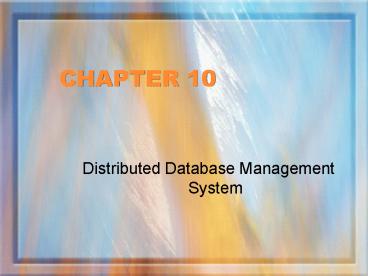Distributed Database Management System - PowerPoint PPT Presentation
1 / 19
Title:
Distributed Database Management System
Description:
User-friendly interface. Less danger of a single-point failure. Processor independence ... Fragmentation transparency user doesn't know db is partitioned ... – PowerPoint PPT presentation
Number of Views:103
Avg rating:3.0/5.0
Title: Distributed Database Management System
1
CHAPTER 10
- Distributed Database Management System
2
1970s
- MIS System
- Support for structured information needs.
- formal reports in standard formats from TPS data.
- 3GL response to precisely channeled request.
- Centrally stored corporate data--mainframe.
- Data access through dumb terminals.
- No ad hoc information for decision makers in a
dynamic business environment.
3
1980s
- DSS
- Business operations more decentralized
geographically. - Global competition.
- Customer demands and market needs--decentralized
management style. - Rapid technological change microcomputers.
- LANs became the basis for computerized solutions.
- applications based on DBMSs--data sharing
attractive.
4
1990s and beyond--DBMS in Dynamic Business
Environment
- Quick ad hoc data access.
- decentralization of management structure and
business units made decentralized multiple-access
and multiple-location databases a necessity. - demand for applications based on data access from
different sources at multiple locations.
5
What Is A Distributed DBMS?
Figure 10.4 Fully Distributed Database Management
System
6
Distributed DBMS
- A fully distributed database management system
(DDBMS) governs - the storage and processing
- of logically related data
- over interconnected computer systems
- in which both data and processing functions
- are distributed among several sites.
7
Distributed Processingand Distributed Database
- Distributed processing shares
- the databases logical processing
- among two or more physically independent sites
- that are connected through a network.
- Distributed database stores
- a logically related database
- over two or more physically independent sites
- connected via a computer network.
8
Functions of a DDBMS
- Application interface
- Validation to analyze data requests
- Transformation to determine requests components
- Query-optimization to find the best access
strategy - Mapping to determine the data location
- I/O interface to read or write data
- Formatting to prepare the data for presentation
- Security to provide data privacy
- Backup and recovery
- DB administration
- Concurrency control
- Transaction management
9
DDBMS Advantages
- Faster data processing
- Growth facilitation
- Data are located near the greatest demand
site. - Faster data access
- Reduced operating costs
- Improved communication
- User-friendly interface
- Less danger of a single-point failure
- Processor independence
10
DDBMS Disadvantages
- Security
- Complexity of management and control
- Lack of standards
11
DDBMS Protocol
- Transaction processor (TP) receives and processes
the applications data requests. - Data processor (DP) stores and retrieves data
located at the site. Also known as data manager
(DM).
12
Distributed DB Transparency Features
- allowing the end users to think that they are the
databases only users. - manage a physically dispersed database as though
it were a centralized database. - Three Levels of Distribution Transparency
- Fragmentation transparencyuser doesnt know db
is partitioned - Location transparencyuser specifies location
name but doesnt know where location is - Local mapping transparencyend user must know
both location name and physically where the
location is
13
Transaction Transparency
- Any transaction will maintain distributed db
integrity and consistency - Remote transactionrequest to database can
reference data at only 1 site - Distributed transactionrequest can reference
data from multiple sites but each single request
gets data from only 1 site - Distributed requestcan request data from
multiple sites and each request can be from
multiple sites
14
Distributed Concurrency Control
- Uses 2-Phase Commit to allow transaction to get
data from multiple sites - DO-UNDO-REDO Protocol with Write Ahead
- DOperforms operation records before and
after in transaction log - UNDO uses log to reverse transaction if needed
- REDOuses log to REDO transaction if needed
- WRITE Aheadtransaction log written to permanent
storage before actual data is changed - Prepare to Commit is sent to all affected
databases - Final Commit
15
Data Fragmentation
- Strategy to decide how database will be stored
- Can be at database level or table level
- Table Fragmentation
- Horizontal Fragmentation SELECT subset
- Vertical Fragmentation PROJECT subset
- Mixed Fragmentation combination
16
Data Replication
- Storing multiple copies of data on the network
- Must ensure data consistency
- Affected by database size and usage frequency
- Mutual Consistency Rule
- All copies of data fragments must be identical
17
Replication Scenarios
- Fully replicated
- Multiple copies at multiple sites
- High overhead to maintain
- Partially replicated
- Multiple copies of some fragments at multiple
sites
18
Design IssuesDistributed Processing
- Must be a division of processing
- Presentation of data
- Manages GUI, user-initiated actions, timers
- Validation
- Consistency of database and user inputs
- Business logic
- Business functions
- Workflow
- Completion of business processes
- Data Access
- SQL statements, queries and modifications
19
Process Management
- Middleware
- Handles client/server communication withouot
regard to platform - Oracle--JDBC































